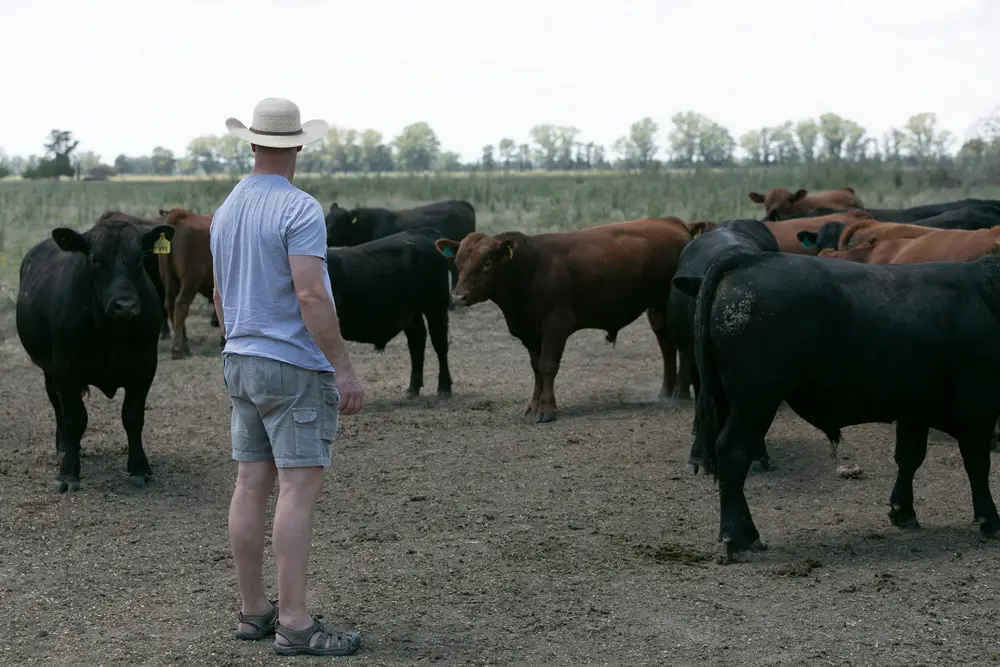To tell if your steer is ready to butcher, look at the brisket, loin, ribs, and tail head to ascertain at what stage your animal is. Using a hand to feel for the fat and bones beneath the skin will indicate how close the steer is to going to slaughter.
Your animal should be in the sweet spot of being well fleshed, i.e., nicely fattened without crossing over into obesity.
Table of Contents
The Tell-Tale Signs
A less-experienced farmer will have to use touch as their most reliable way of detecting whether their cattle are ready for slaughter. As you gain knowledge and become more skilled, you can decide whether your animals are butcher-ready with only the naked eye.
To begin with, inspect four regions on the steer: The brisket, ribs, loin, and tail head.
The brisket is the loose fold of skin between a cow’s front legs if you look at it head-on. This area should be full and ripple slightly as it moves. The bones beneath the skin in the rib and loin area should not be prominent, but you should be able to feel them and a moderate layer of fat as you run your hand along the hide in those areas.
The rump should be full, and the area around the tail head should have easily visible rolls of moderate fat (three folds is the perfect number).
A full brisket and tail head mean that the beef should be at its optimum level of marbling. A prominent spine means finishing is still not complete.
When ready, the animal’s overall aspect should combine a healthy proportion of muscle and fat. It should have a shiny, smooth coat and be alert and responsive.
A Decent Fat Covering
Animals should have a decent fat covering but not too much, and their cattle weight should correspond with the standard weight for the breed. If you have larger animals, check that the slaughterhouse, grader, or factory can manage their larger size.

If you sell live animals, they should be medium-weight and slightly lighter than factory animals. Again, the hanging weight of dead cattle should fit the specifications of the factory or processor you are sending them to.
Steers reared on full feed (eating as much grain as they want plus additional hay) should be butcher-ready when they reach 14 to 18 months of age. Fully grass-fed steers take 26 to 28 months to reach that stage.
What geneticist Abbygale Moran revealed at the BSAS annual conference in Chester, England (April 2016) is also worth bearing in mind: “Farmers finish most beef animals on 24-month systems, but our research has found that 12 months is the optimal time to slaughter beef animals.”
Incidentally, there is no point in continuing to feed cattle that are not growing after the 90-day finishing period.
Common Breeds Ready for Butcher
| Breed | Time To Butcher |
| Ayrshire | 18 months |
| Beefmaster | 12 to 18 months |
| Belted Galloway | 18 to 24 months |
| Black Angus | 2 years |
| Brahman | 2 years |
| Brangus | 14 to 18 months |
| Charolais | 2 years |
| Chianina | 19 to 20 months |
| Dexter | 22 to 24 months |
| Gelbvieh | 2 years |
| Hereford | 2 years |
| Holstein-Friesian | 12 to 24 months |
| Limousin | 2 years |
| Maine Anjou | 2½ years |
| Murray Grey | 1 year |
| Piedmontese | 20 months |
| Red Angus | 2 years |
| Santa Gertrudis | 2 years |
| Shorthorn | 9 to 14 months |
| Simmental | 2 years |
| Texas Longhorn | 1 to 2 years |
| Zebu | 3½ to 4 years |
Rearing and Finishing
Smaller steers will finish before larger-framed ones, and a good rule of thumb is that short and wide finish before short and thin or tall and wide. Larger-framed cattle need plenty of calories daily to sustain and keep themselves healthy, and this invariably slows down their growth rate.
Diet is crucial as well. Even an animal with the finest genetic background will not finish more quickly than one with a full diet of high-quality forage. Be careful when it comes to supplementing their feed regimen with grain. Grain will help an animal gain weight, but it should only be used in moderation as cattle cannot digest it easily.
Smaller Replacement Heifers
Indeed, smaller replacement heifers are more economical if reproduction in the herd is unchecked. Reduced fat deposits and body growth can raise the weight that small cattle achieve at the time of slaughter. Calves that demonstrate a slower growth rate will grow more slowly in the feedlot than those that finish directly after weaning.
A pasture-only diet is inadequate for larger heifers to reach early puberty, and too much supplemental feed can lower milk production by raising fat levels in the udder. A specific and tailored number of hormones and particular nutrients can regulate mature body protein and fat deposition.
